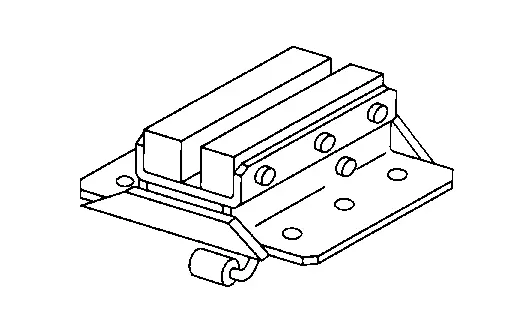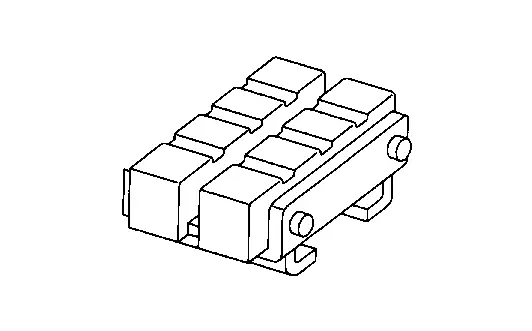Nissan Pathfinder: General Information - Precautions
Description
Observe the following precautions to ensure safe and proper servicing. These precautions are not described in each individual section.
Precaution for Supplemental Restraint System (SRS) "AIR BAG" and "SEAT BELT PRE-TENSIONER"
The Supplemental Restraint System such as “AIR BAG” and “SEAT BELT PRE-TENSIONER”, used along with a front seat belt, helps to reduce the risk or severity of injury to the driver and front passenger for certain types of collisions.
Information necessary to service the system safely is included in the “SRS AIR BAG” and “SEAT BELT” sections of this Service Manual.
WARNING:
Always observe the following items for preventing accidental activation:
To avoid rendering the SRS inoperative, which could increase the risk of personal injury or death in the event of a collision that would result in air bag inflation, it is recommended that all maintenance and repair be performed by an authorized NISSAN/INFINITI dealer. Improper repair, including incorrect removal and installation of the SRS, can lead to personal injury caused by unintentional activation of the system. For removal of Spiral Cable and Air Bag Module, see “SRS AIR BAG”. Never use electrical test equipment on any circuit related to the SRS unless instructed to in this Service Manual. SRS wiring harnesses can be identified by yellow and/or orange harnesses or harness connectors.
PRECAUTIONS WHEN USING POWER TOOLS (AIR OR ELECTRIC) AND HAMMERS
WARNING:
Always observe the following items for preventing accidental activation:
When working near the Air Bag Diagnosis Sensor Unit or other Air Bag System sensors with the ignition/power switch ON or engine running, never use air or electric power tools or strike near the sensor(s) with a hammer. Heavy vibration could activate the sensor(s) and deploy the air bag(s), possibly causing serious injury. When using air or electric power tools or hammers, always switch the ignition/power switch OFF, disconnect the 12V battery or batteries, and wait at least 3 minutes before performing any service.
Precaution for Procedure without Cowl Top Cover
When performing the procedure after removing cowl top cover, cover the lower end of windshield with urethane, etc to prevent damage to windshield.
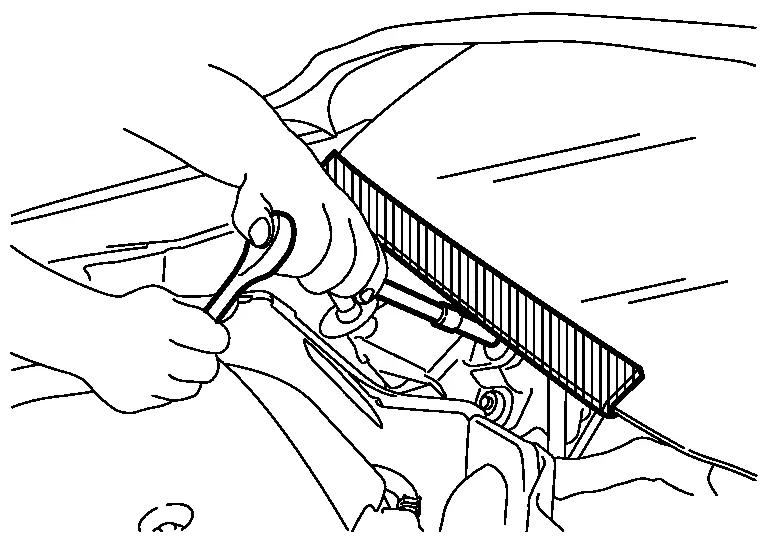
Cautions in Removing Battery Terminal and AV Control Unit
CAUTION:
Remove battery terminal and AV control unit after a lapse of 30 seconds or more after placing the ignition switch OFF.
 NOTE:
NOTE:
After the ignition switch is placed OFF, the AV control unit continues operating for approximately 30 seconds.
Therefore, data corruption may occur if battery voltage is cut off within 30 seconds.
General Precautions
-
Do not operate the engine for an extended period of time without proper exhaust ventilation.
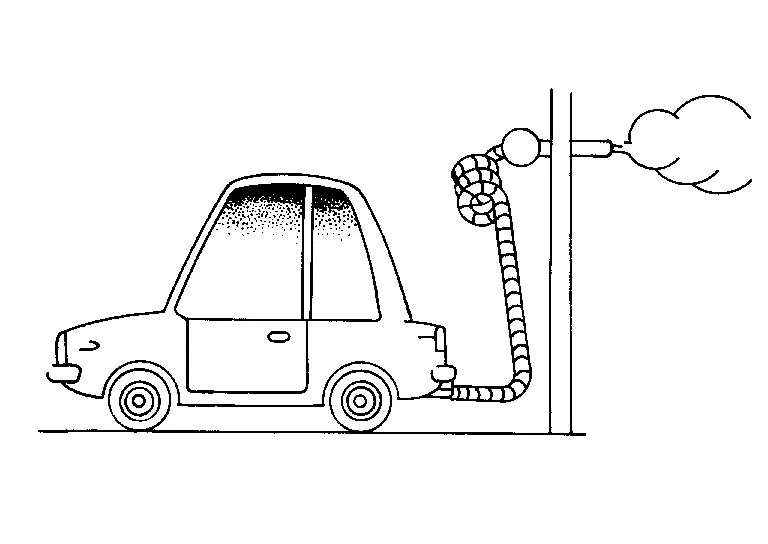
Keep the work area well ventilated and free of any inflammable materials. Special care should be taken when handling any inflammable or poisonous materials, such as gasoline, refrigerant gas, etc. When working in a pit or other enclosed area, be sure to properly ventilate the area before working with hazardous materials.
Do not smoke while working on the Nissan Pathfinder vehicle.
-
Before jacking up the vehicle, apply wheel chocks or other tire blocks to the wheels to prevent the Nissan Pathfinder vehicle from moving. After jacking up the vehicle, support the vehicle weight with safety stands at the points designated for proper lifting before working on the Nissan Pathfinder vehicle.
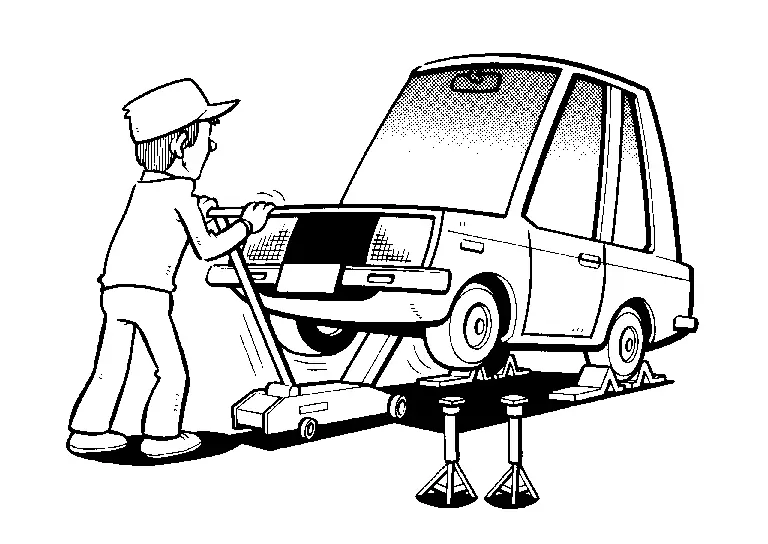
These operations should be done on a level surface.
-
When removing a heavy component such as the engine or transaxle/transmission, be careful not to lose your balance and drop them. Also, do not allow them to strike adjacent parts, especially the brake tubes and master cylinder.
-
Before starting repairs which do not require battery power:
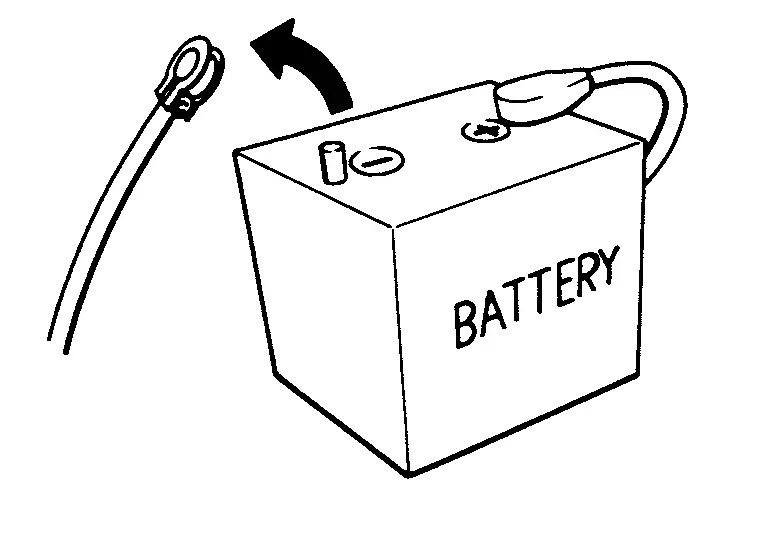
Ignition switch OFF.
Disconnect the negative battery terminal.
-
If the battery terminals are disconnected, recorded memory of radio and each control unit is erased.
-
To prevent serious burns:
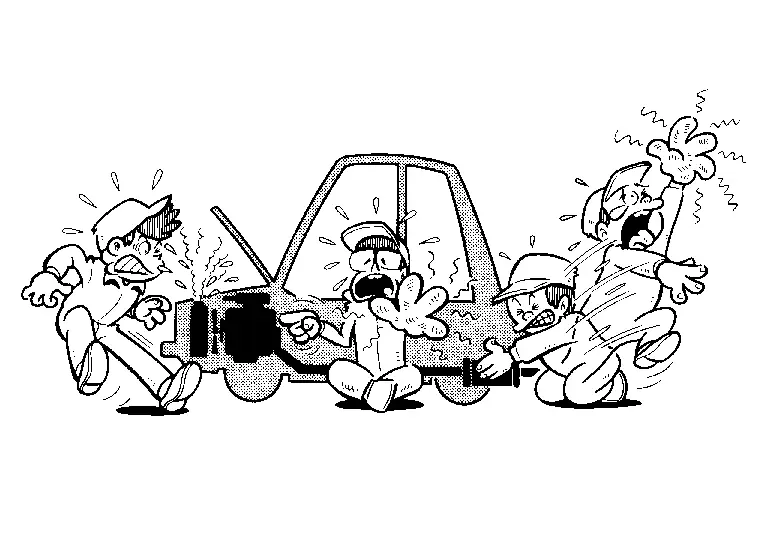
Avoid contact with hot metal parts.
Do not remove the radiator cap when the engine is hot.
-
Dispose of drained oil or the solvent used for cleaning parts in an appropriate manner.
-
Do not attempt to top off the fuel tank after the fuel pump nozzle shuts off automatically.
Continued refueling may cause fuel overflow, resulting in fuel spray and possibly a fire.
-
Clean all disassembled parts in the designated liquid or solvent prior to inspection or assembly.
-
Replace oil seals, gaskets, packings, O-rings, locking washers, cotter pins, self-locking nuts, etc. with new ones.
-
Replace inner and outer races of tapered roller bearings and needle bearings as a set.
-
Arrange the disassembled parts in accordance with their assembled locations and sequence.
-
Do not touch the terminals of electrical components which use microcomputers (such as ECM).
Static electricity may damage internal electronic components.
-
After disconnecting vacuum or air hoses, attach a tag to indicate the proper connection.
-
Use only the fluids and lubricants specified in this manual.
-
Use approved bonding agent, sealants or their equivalents when required.
-
Use hand tools, power tools (disassembly only) and recommended special tools where specified for safe and efficient service repairs.
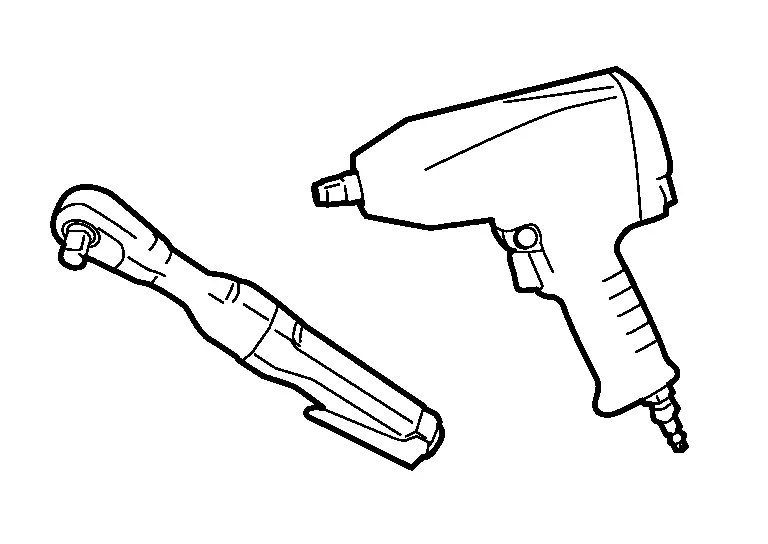
-
When repairing the fuel, oil, water, vacuum or exhaust systems, check all affected lines for leakage.
-
Before servicing the Nissan Pathfinder vehicle:
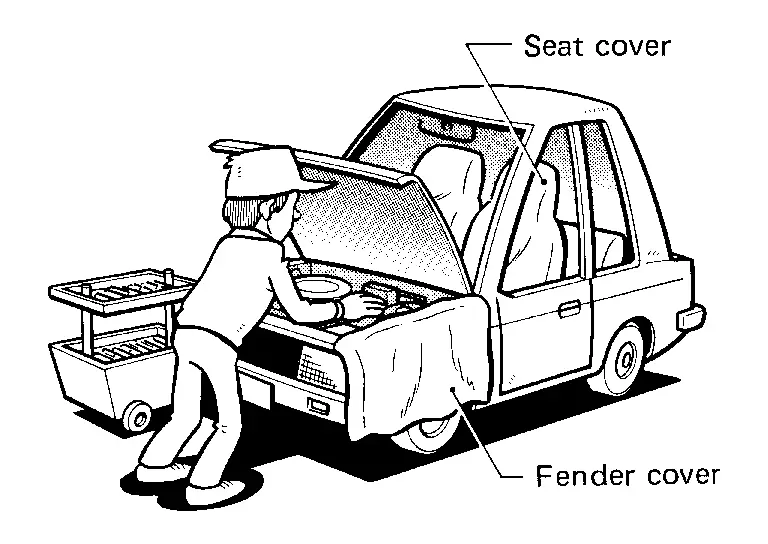
Protect fenders, upholstery and carpeting with appropriate covers.
Take caution that keys, buckles or buttons do not scratch paint.
WARNING:
To prevent ECM from storing the diagnostic trouble codes, never carelessly disconnect the harness connectors which are related to the engine control system and TCM (transmission control module) system. The connectors should be disconnected only when working according to the WORK FLOW of TROUBLE DIAGNOSES in EC and TM sections.
Three Way Catalyst
If a large amount of unburned fuel flows into the catalyst, the catalyst temperature will be excessively high. To prevent this, follow the instructions.
-
Use unleaded gasoline only. Leaded gasoline will seriously damage the three way catalyst.
-
When checking for ignition spark or measuring engine compression, make tests quickly and only when necessary.
-
Do not run engine when the fuel tank level is low, otherwise the engine may misfire, causing damage to the catalyst.
Do not place the vehicle on flammable material. Keep flammable material off the exhaust pipe and the three way catalyst.
Multiport Fuel Injection System or Engine Control System
-
Before connecting or disconnecting any harness connector for the multiport fuel injection system or ECM:
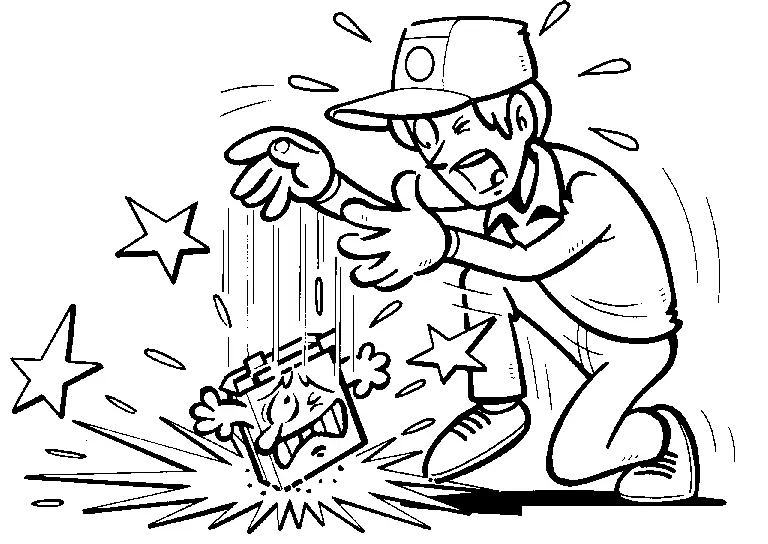
Ignition switch OFF.
Disconnect negative battery terminal.
Otherwise, there may be damage to ECM.
-
Before disconnecting pressurized fuel line from fuel pump to injectors, be sure to release fuel pressure.
-
Be careful not to jar components such as ECM and mass air flow sensor.
Hoses
HOSE REMOVAL AND INSTALLATION
-
To prevent damage to rubber hose, do not pry off rubber hose with tapered tool or screwdriver.
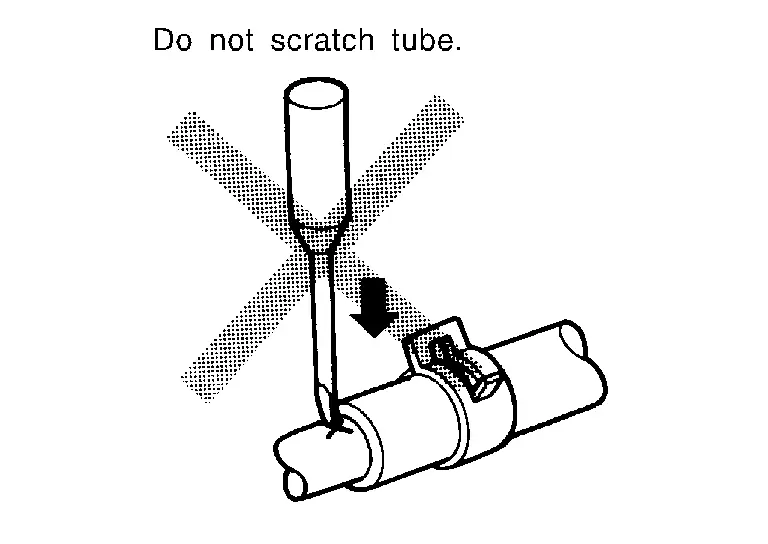
-
To reinstall the rubber hose securely, check that hose insertion length and orientation is correct. (If tube is equipped with hose stopper, insert rubber hose into tube until it butts up against hose stopper.)
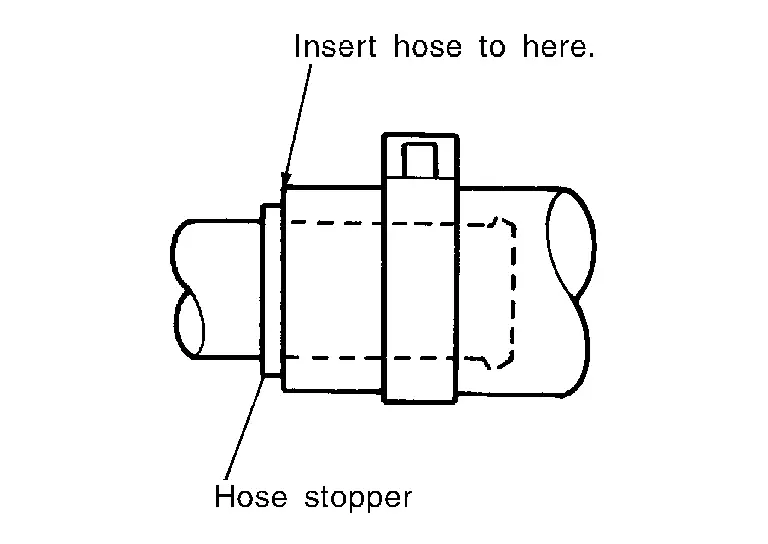
HOSE CLAMPING
-
If old rubber hose is re-used, install hose clamp in its original position (at the indentation where the old clamp was). If there is a trace of tube bulging left on the old rubber hose, align rubber hose at that position.
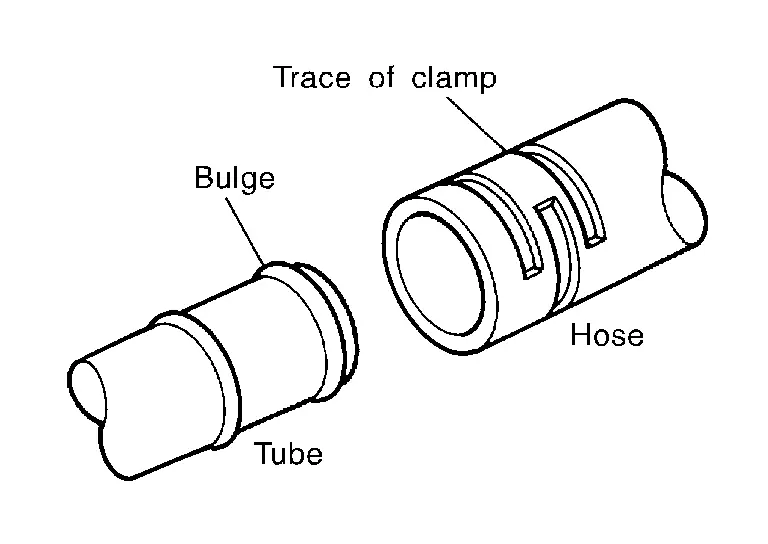
-
Discard old clamps; replace with new ones.
-
After installing plate clamps, apply force to them in the direction of the arrow, tightening rubber hose equally all around.
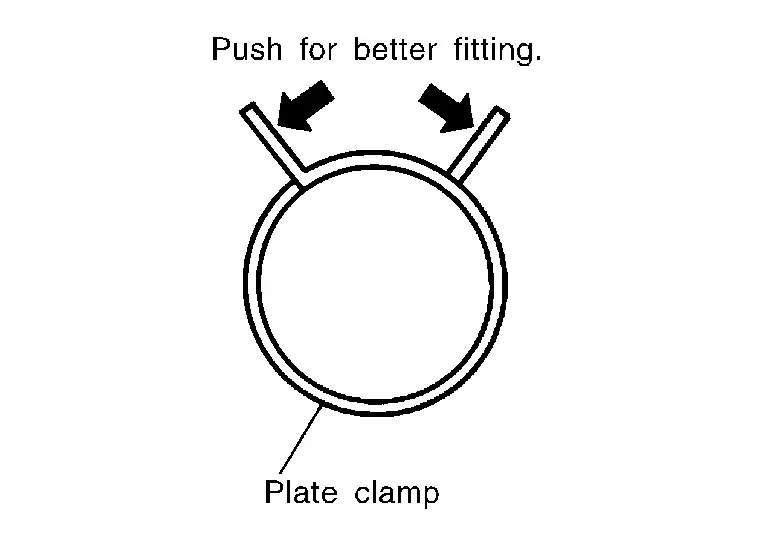
Engine Oils
Prolonged and repeated contact with used engine oil may cause skin cancer. Try to avoid direct skin contact with used oil.
If skin contact is made, wash thoroughly with soap or hand cleaner as soon as possible.
HEALTH PROTECTION PRECAUTIONS
-
Avoid prolonged and repeated contact with oils, particularly used engine oils.
-
Wear protective clothing, including impervious gloves where practicable.
-
Do not put oily rags in pockets.
-
Avoid contaminating clothes, particularly underpants, with oil.
-
Heavily soiled clothing and oil-impregnated footwear should not be worn. Overalls must be cleaned regularly.
-
First aid treatment should be obtained immediately for open cuts and wounds.
-
Use barrier creams, applying them before each work period, to help the removal of oil from the skin.
-
Wash with soap and water to ensure all oil is removed (skin cleansers and nail brushes will help). Preparations containing lanolin replace the natural skin oils which have been removed.
-
Do not use gasoline, kerosene, diesel fuel, gas oil, thinners or solvents for cleaning skin.
-
If skin disorders develop, obtain medical advice without delay.
-
Where practical, degrease components prior to handling.
-
Where there is a risk of eye contact, eye protection should be worn, for example, chemical goggles or face shields; in addition an eye wash facility should be provided.
ENVIRONMENTAL PROTECTION PRECAUTIONS
Dispose of used oil and used oil filters through authorized waste disposal contractors to licensed waste disposal sites, or to the waste oil reclamation trade. If in doubt, contact the local authority for advice on disposal facilities.
It is illegal to pour used oil on to the ground, down sewers or drains, or into water sources.
The regulations concerning pollution vary between regions.
Air Conditioning
Use an approved refrigerant recovery unit any time the air conditioning system must be discharged. Refer to HA section “REFRIGERANT” for specific instructions.
Fuel
ROCK CREEK® PATHFINDER MODEL
Use unleaded premium gasoline with an octane rating of at least 91 AKI (Anti-Knock Index) number (Research octane number 96).
If unleaded premium gasoline is not available, unleaded regular gasoline with an octane rating of at least 87 AKI number (Research octane number 91) may be temporarily used, but only under the following precautions:
-
Have the fuel tank filled only partially with unleaded regular gasoline, and fill up with unleaded premium gasoline as soon as possible.
-
Avoid full throttle driving and abrupt acceleration.
Use unleaded premium gasoline for maximum vehicle performance.
CAUTION:
-
Using a fuel other than that specified could adversely affect the emission control system, and may also affect the warranty coverage.
-
Under no circumstances should a leaded gasoline be used, because this will damage the three-way catalyst.
-
Do not use a fuel containing more than 15% ethanol in your Nissan Pathfinder vehicle. Your vehicle is not designed to run on a fuel containing more than 15% ethanol. Using a fuel containing more than 15% ethanol in a Nissan Pathfinder vehicle not specifically designed for a fuel containing more than 15% ethanol can adversely affect the emission control devices and systems of the Nissan Pathfinder vehicle. Damage caused by such fuel is not covered by the NISSAN/INFINITInew vehicle limited warranty.
-
Do not use fuel that contains the octane booster methylcyclopentadienyl manganese tricarbonyl (MMT). Using fuel containing MMT may adversely affect Nissan Pathfinder vehicle performance and vehicle emissions. Not all fuel dispensers are labeled to indicate MMT content, so you may have to consult your gasoline retailer for more details. Note that Federal and California laws prohibit the use of MMT in reformulated gasoline.
-
U.S. government regulations require ethanol dispensing pumps to be identified by a small, square, orange and black label with the common abbreviation or the appropriate percentage for that region.
Use unleaded regular gasoline with an octane rating of at least 87 AKI (Anti-Knock Index) number (Research octane number 91).
CAUTION:
-
Only vehicles with the E-85 filler door label can operate on E-85. Fuel system or other damage can occur if E-85 is used in Nissan Pathfinder vehicles that are not designed to run on E-85.
-
Using a fuel other than that specified could adversely affect the emission control system, and may also affect the warranty coverage.
-
Under no circumstances should a leaded gasoline be used, because this will damage the three-way catalyst.
-
Do not use a fuel containing more than 15% ethanol in your Nissan Pathfinder vehicle. Your vehicle is not designed to run on a fuel containing more than 15% ethanol. Using a fuel containing more than 15% ethanol in a Nissan Pathfinder vehicle not specifically designed for a fuel containing more than 15% ethanol can adversely affect the emission control devices and systems of the Nissan Pathfinder vehicle. Damage caused by such fuel is not covered by the NISSAN new vehicle limited warranty.
-
Do not use fuel that contains the octane booster methylcyclopentadienyl manganese tricarbonyl (MMT). Using fuel containing MMT may adversely affect Nissan Pathfinder vehicle performance and vehicle emissions. Not all fuel dispensers are labeled to indicate MMT content, so you may have to consult your gasoline retailer for more details. Note that Federal and California laws prohibit the use of MMT in reformulated gasoline.
-
U.S. government regulations require ethanol dispensing pumps to be identified by a small, square, orange and black label with the common abbreviation or the appropriate percentage for that region.
PATHFINDER MODELS (EXCEPT MEXICO ONLY)
Use unleaded regular gasoline with an octane rating of at least 87 AKI (Anti-Knock Index) number (Research octane number 91).
CAUTION:
Do not use leaded gasoline. Using leaded gasoline will damage the three-way catalyst.
Lifting Point Nissan Pathfinder
Special Service Tool
The actual shapes of Kent-Moore tools may differ from those of special service tools illustrated here.
|
Tool number (Kent-Moore No.) Tool name |
Description |
|---|---|
|
LM4086-0200 ( - ) Board on attachment |
|
|
LM4519-0000 ( - ) Safety stand attachment |
|
CAUTION:
-
Every time the vehicle is lifted up, maintain the complete vehicle curb condition.
-
Since the Nissan Pathfinder vehicle's center of gravity changes when removing main parts on the front side (engine, transmission, suspension etc.), support a jack up point on the rear side garage jack with a transmission jack or equivalent.
-
Since the Nissan Pathfinder vehicle's center of gravity changes when removing main parts on the rear side (rear axle, suspension, etc.), support a jack up point on the front side garage jack with a transmission jack or equivalent.
-
Be careful not to smash or do anything that would affect piping parts.
Pantograph Jack
WARNING:
-
Never get under the vehicle while it is supported only by the jack. Always use safety stands to support the frame when you have to get under the Nissan Pathfinder vehicle.
-
Place wheel chocks at both front and back of the wheels on the ground.
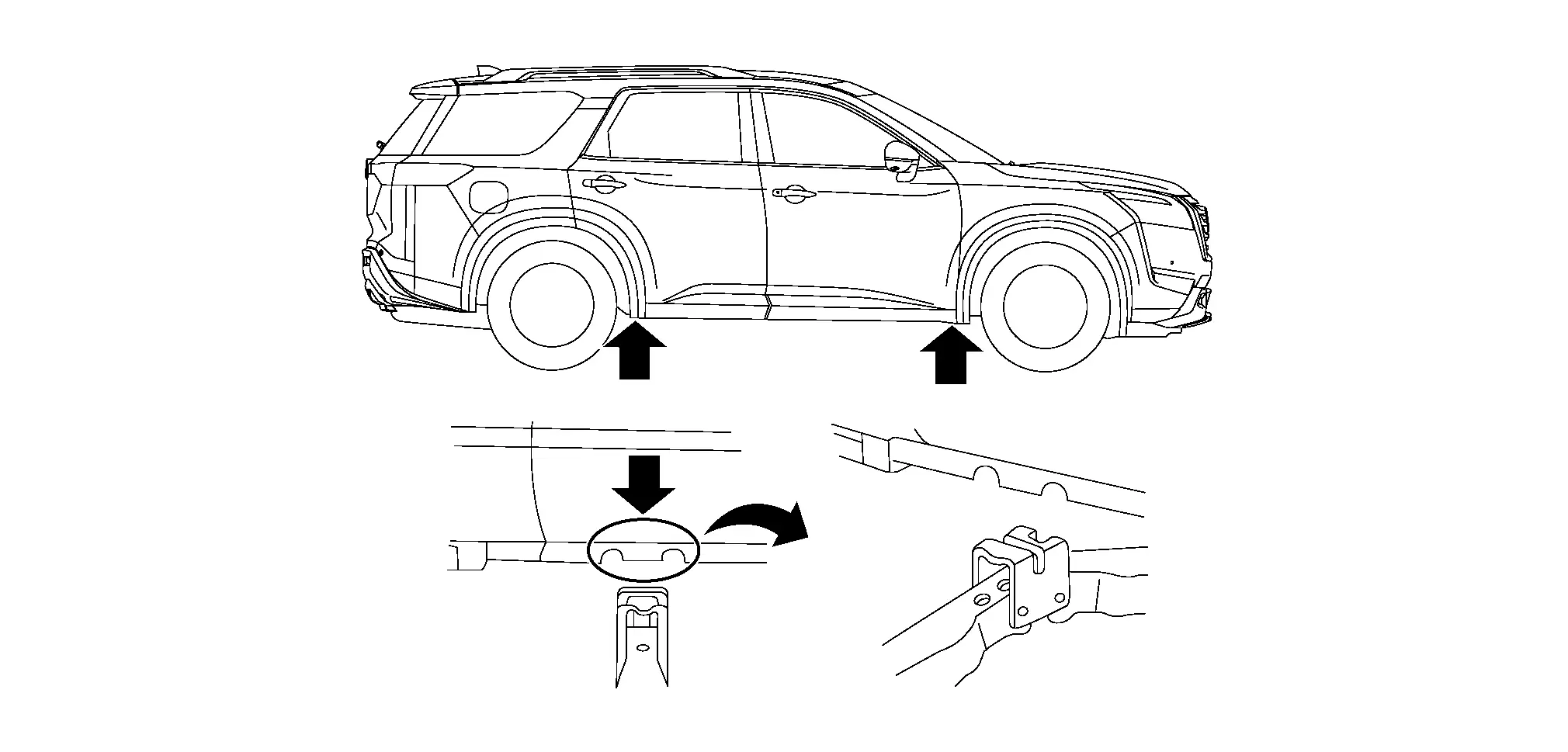
Garage Jack and Safety Stand and 2-Pole Lift
WARNING:
-
Park the vehicle on a level surface when using the jack. Check to avoid damaging pipes, tubes, etc. under the Nissan Pathfinder vehicle.
-
Never get under the vehicle while it is supported only by the jack. Always use safety stands when you have to get under the Nissan Pathfinder vehicle.
-
Place wheel chocks at both front and back of the wheels on the ground.
-
When lifting the Nissan Pathfinder vehicle, open the lift arms as wide as possible and ensure that the front and rear of the vehicle are well balanced.
-
When setting the lift arm, never allow the arm to contact the brake tubes, brake cable, fuel lines and sill spoiler.
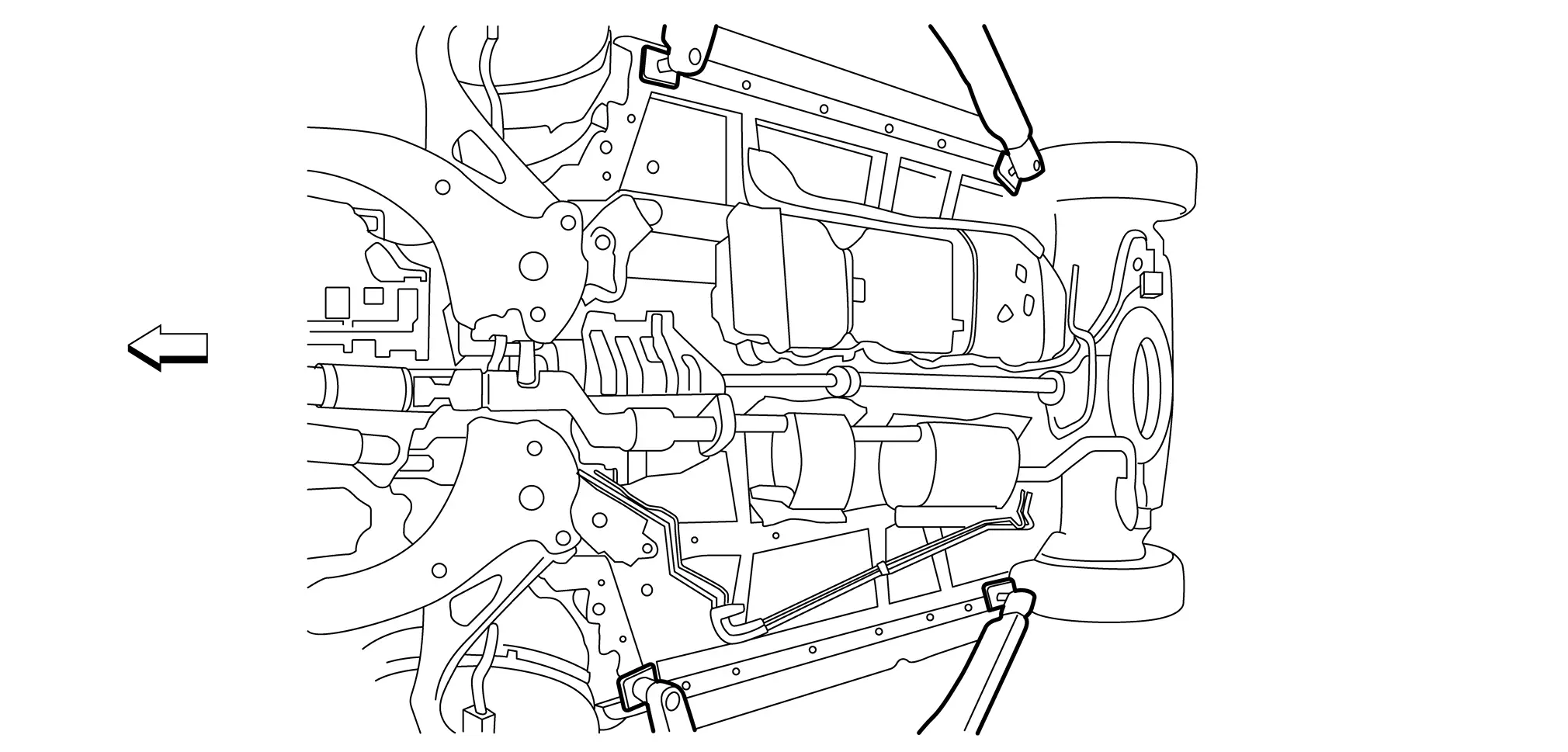
 |
: Nissan Pathfinder Vehicle front | ||||
CAUTION:
There is canister just behind Garage jack point rear. Jack up carefully.
Clearance Check for Common Adapters
Service Hoist with Running Boards
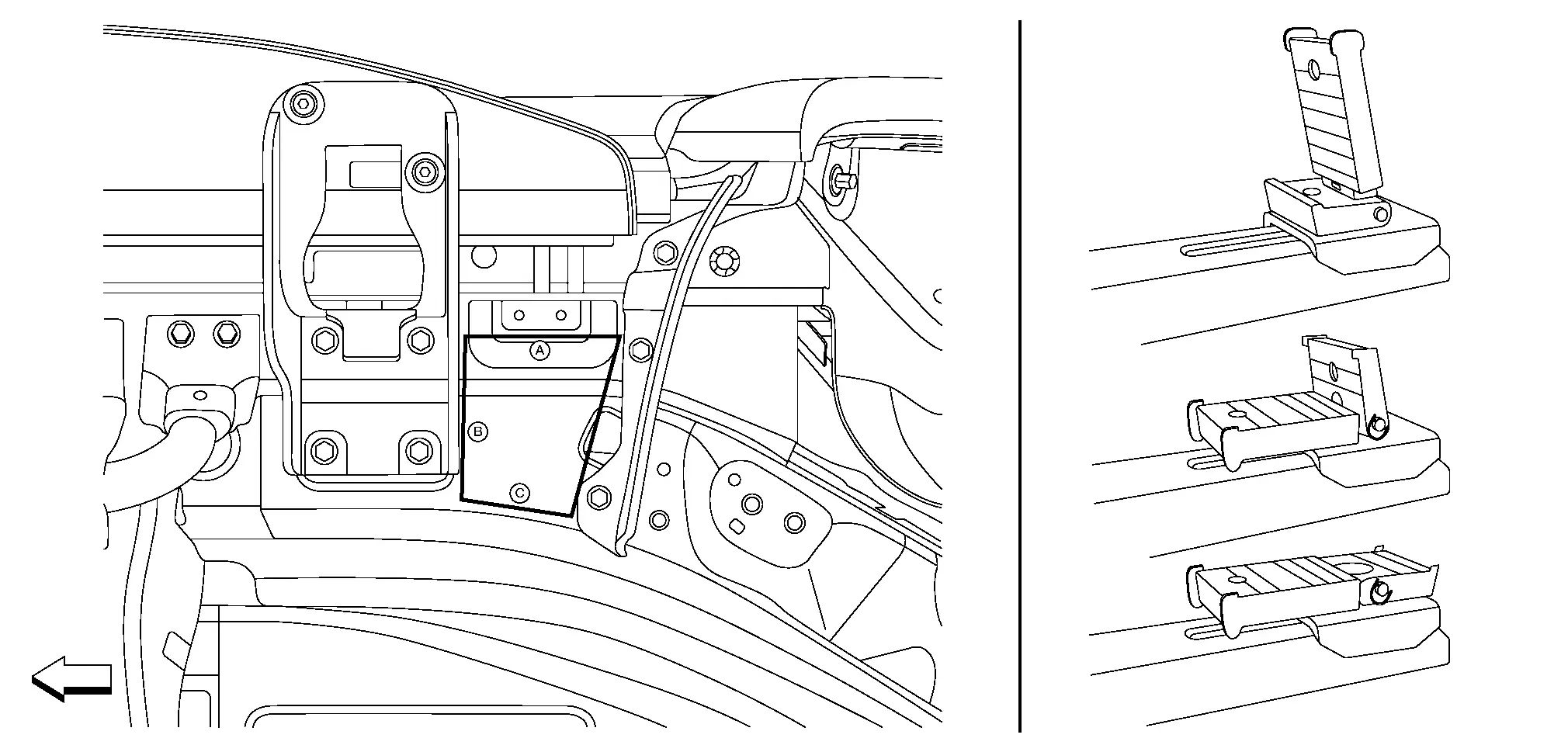
 |
: Nissan Pathfinder Vehicle front | ||||
| No. | Measurements |
|---|---|
| A. | 4.13in (105mm) |
| B. | 4.33in (110mm) |
| C. | 3.07in (78mm) |

 |
: Nissan Pathfinder Vehicle front | ||||
| No. | Measurements |
|---|---|
| A. | 4.45in (113mm) |
| B. | 6.93in (176mm) |
| C. | 3.54in (90mm) |
| D. | 5.63in (143mm) |
| No. | Measurements |
|---|---|
| 1. | 5.71in (145mm) |
| 2. | 3.54in (90mm) |
| 3. | 4.33in (110mm) |
| 4. | 3.35in (85mm) |
| 5. | 5.24in (133mm) |
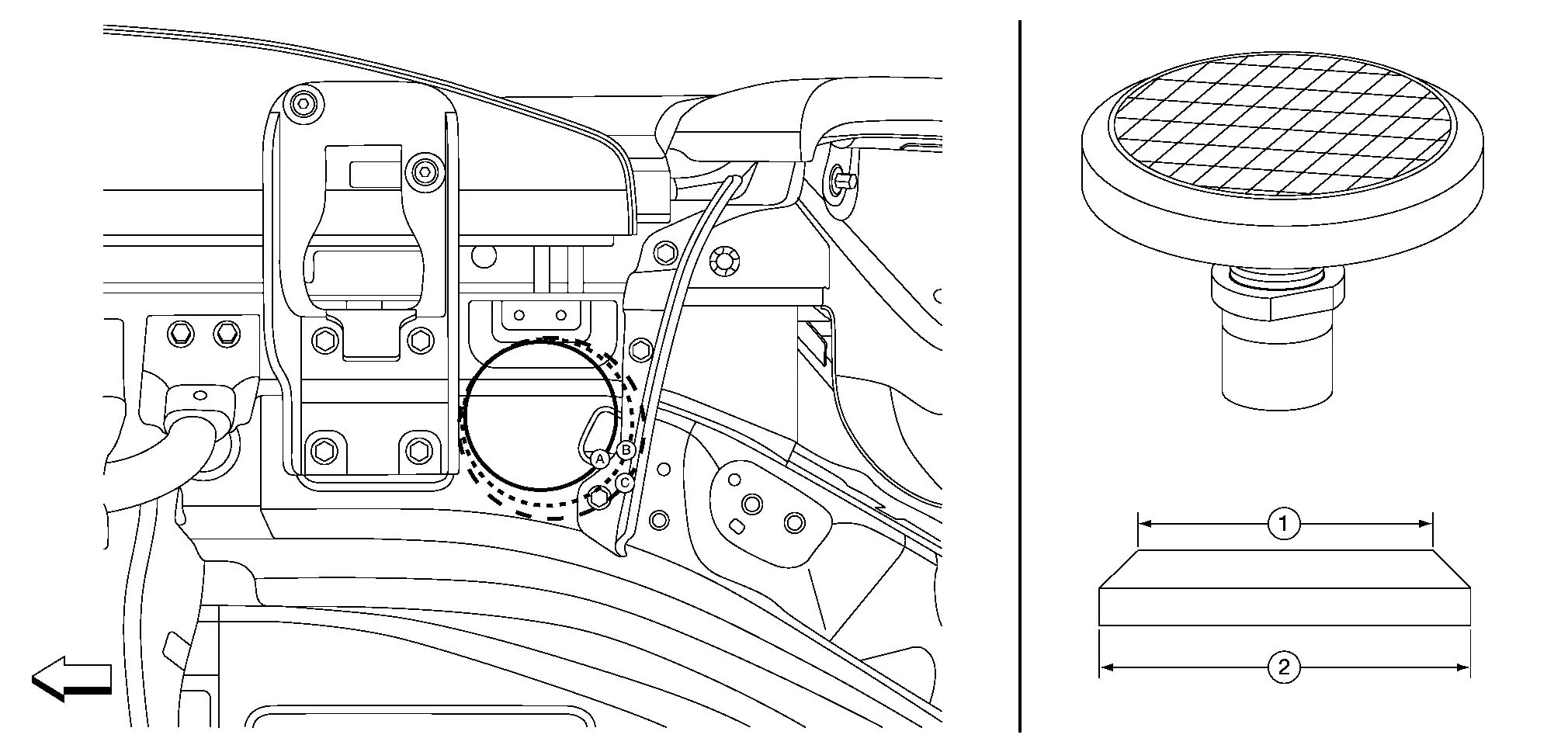
 |
: Nissan Pathfinder Vehicle front | ||||
| No. | Measurements |
|---|---|
| A. | 4.13in (105mm) - up against VE Jack reinforcement |
| B. | 4.57in (116mm) - close to Splash Guard bolts with rubber pad |
| C. | 4.72in (120mm) - close to Splash Guard – on top of bolts with rubber pad |
| No. | Measurements |
|---|---|
| 1. | 4.33in (110mm) |
| 2. | 4.92in (125mm) |
Tow Truck Towing Nissan Pathfinder R53
Tow Truck Towing
WARNING:
-
Never ride in a vehicle that is being towed.
-
Never get under your Nissan Pathfinder vehicle after it has been lifted by a tow truck.
CAUTION:
-
All applicable state or Provincial (in Canada) laws and local laws regarding the towing operation must be obeyed.
-
It is necessary to use proper towing equipment to avoid possible damage to the Nissan Pathfinder vehicle during towing operation. Towing is in accordance with Towing Procedure Manual at dealer.
-
Always attach safety chains before towing.
-
When towing, check that the transmission, steering system and powertrain are in good order. If any unit is damaged, dollies must be used.
2WD MODELS
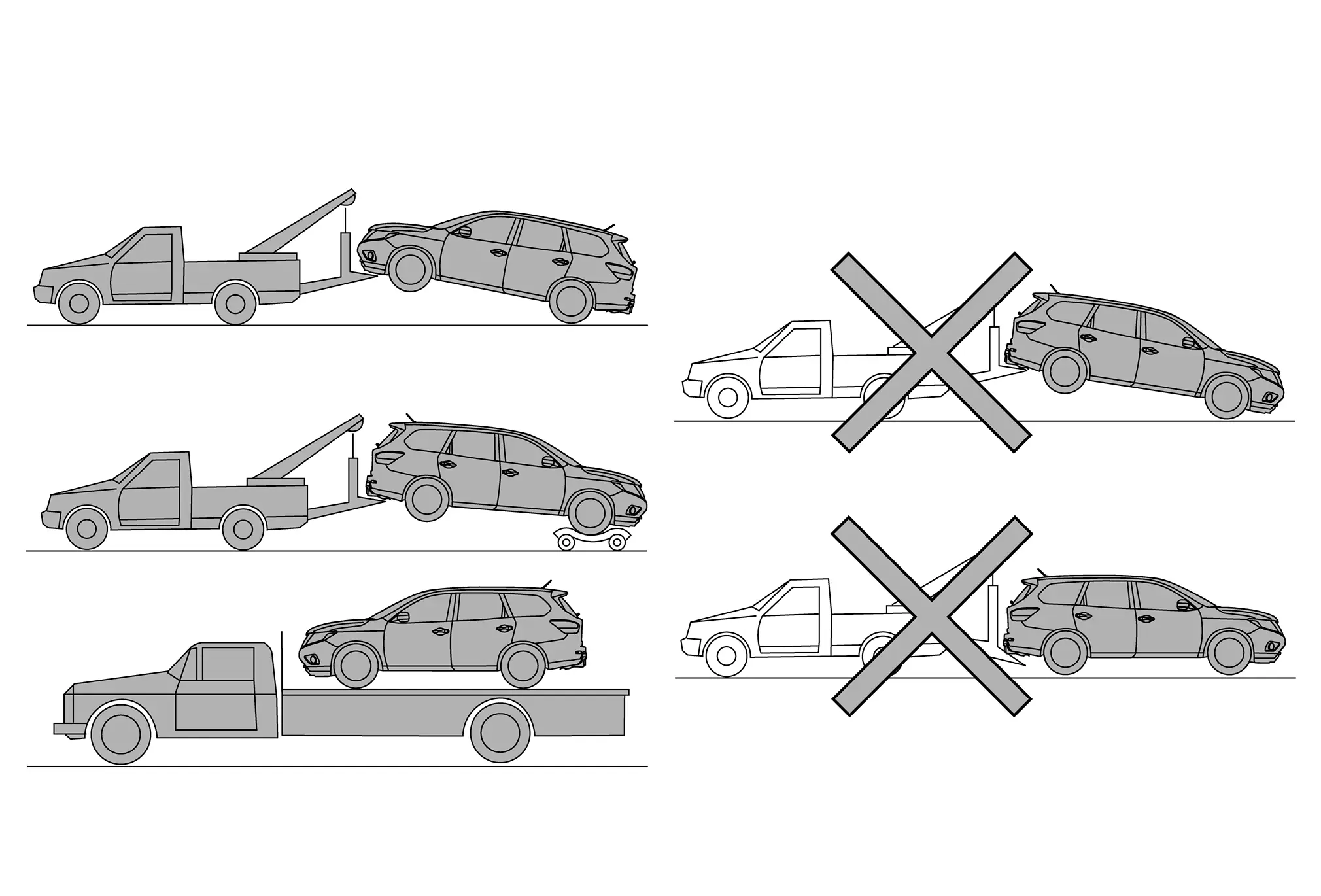
NISSAN recommends that vehicle be towed with the driving (front) wheels off the ground or that a dolly be used as illustrated.
CAUTION:
-
Never tow automatic transmission models with the front wheels on the ground or four wheels on the ground (forward or backward), as this may cause serious and expensive damage to the transmission.
If it is necessary to tow the Nissan Pathfinder vehicle with the rear wheels raised, always use towing dollies under the front wheels.
-
When towing automatic transmission models with the front wheels on towing dollies:
-
Place ignition switch OFF, and secure the steering wheel in a straight ahead position with a rope or similar device. Never secure the steering wheel by turning the ignition switch to the LOCK position. This may damage the steering lock mechanism.
-
Move the selector lever to the N (Neutral) position.
-
-
When the battery of Nissan Pathfinder vehicle equipped with the Intelligent Key system is discharged, your vehicle should be towed with the front wheels on towing dollies or place the Nissan Pathfinder vehicle on a flat bed truck.
-
When towing two wheel drive automatic transmission models with the rear wheels on the ground (if you do not use towing dollies): Always release the parking brake.
-
Do not use the Nissan Pathfinder vehicle tie-downs to tow a vehicle. The vehicle tie-downs should only be used for train, air and sea shipping.
CAUTION:
To avoid the risk of minor injury or property damage:
If the 12-volt battery has low or no voltage, the transmission cannot be shifted into neutral. To transport the Nissan Pathfinder vehicle, it must have all four wheels off the ground and placed on a flatbed or track system.
4WD MODELS
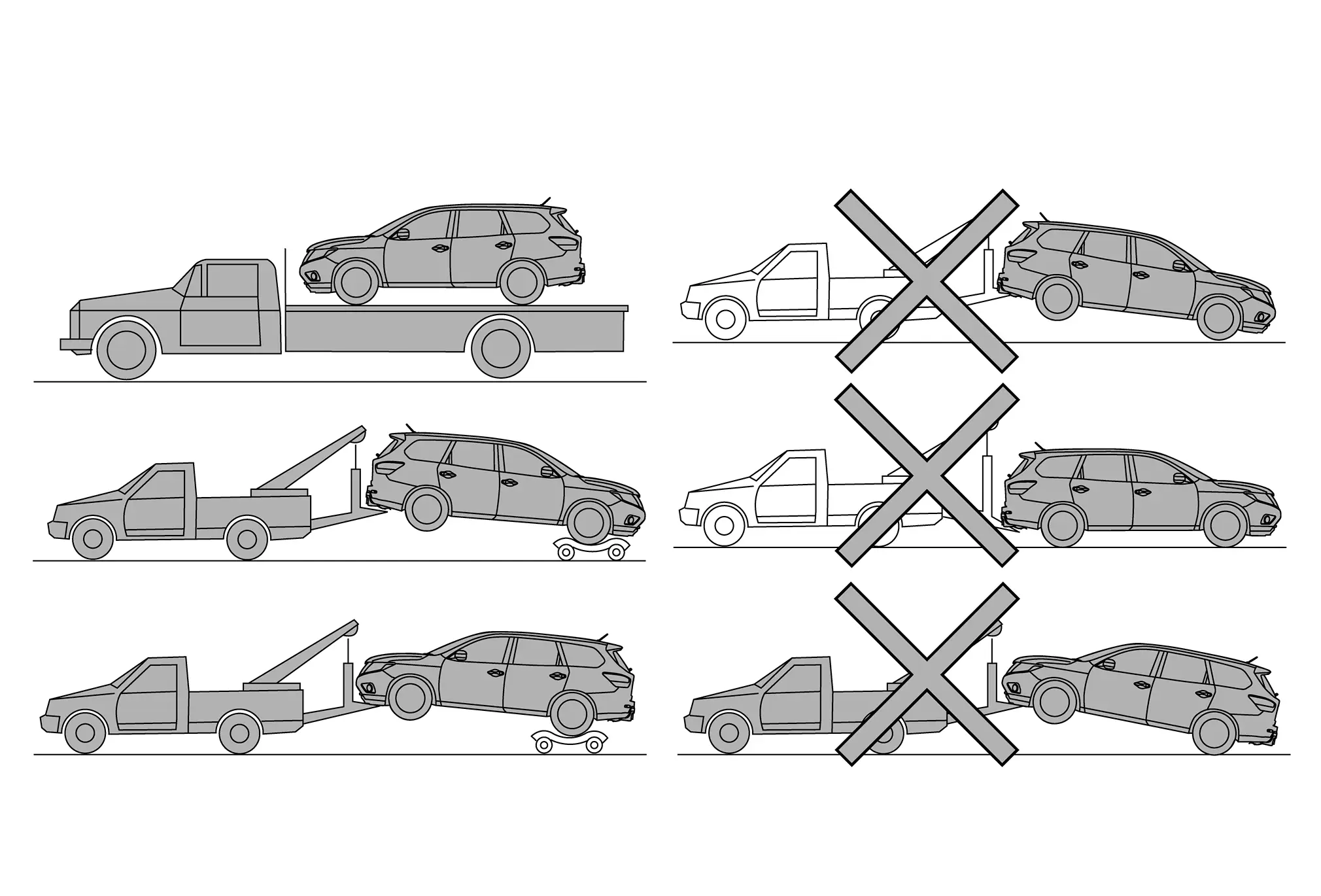
NISSAN recommends that a dolly be used as illustrated when towing 4WD models.
CAUTION:
Never tow 4WD models with any of the wheels on the ground as this may cause serious and expensive damage to the powertrain.
CAUTION:
To avoid the risk of minor injury or property damage:
If the 12-volt battery has low or no voltage, the transmission cannot be shifted into neutral. To transport the Nissan Pathfinder vehicle, it must have all four wheels off the ground and placed on a flatbed or track system.
Vehicle Recovery (Freeing a Stuck Vehicle)
There are two options to recover a stuck vehicle: pulling and rocking
PULLING A STUCK VEHICLE
WARNING:
To avoid vehicle damage, serious personal injury or death when recovering a stuck Nissan Pathfinder vehicle:
Contact a professional towing service to recover the vehicle if you have any questions regarding the recovery procedure. Tow chains or cables must be attached only to the Nissan Pathfinder vehicle recovery hooks or main structural members of the vehicle. Otherwise, the vehicle body will be damaged. Do not use the Nissan Pathfinder vehicle tie-downs to tow or free a stuck vehicle. Only use devices specifically designed for Nissan Pathfinder vehicle recovery and follow the manufacturer’s instructions. Always pull the recovery device straight out from the front of the Nissan Pathfinder vehicle. Never pull at an angle Route recovery devices so they do not touch any part of the Nissan Pathfinder vehicle except the attachment point.
If your vehicle is stuck in sand, snow, mud, etc.,use a tow strap or other device designed specifically for Nissan Pathfinder vehicle recovery. Always follow the manufacturer’s instructions for the recovery device.
ROCKING A STUCK VEHICLE
WARNING:
-
Stand clear of a stuck vehicle.
-
Do not spin your tires at high speed.This could cause them to explode and result in serious injury. Parts of your Nissan Pathfinder vehicle could also overheat and be damaged.
If the vehicle is stuck in sand, snow, mud, etc., use the following procedure:
-
Turn off the Vehicle Dynamic Control System.
-
Check the area in front and behind the Nissan Pathfinder vehicle is clear of obstructions.
-
Turn the steering wheel right and left to clear an area around the front tires.
-
Slowly rock the Nissan Pathfinder vehicle forward and backward.
Shift back and forth between R (reverse) and D (drive).
Apply the accelerator as little as possible to maintain the rocking motion.
Release the accelerator pedal before shifting between R (reverse) and D (drive).
Do not spin the tires above 35 mph (55 km/h).
-
If the Nissan Pathfinder vehicle cannot be freed after a few tries, contact a professional towing service to remove the vehicle.

Nissan Pathfinder (R53) 2022-2025 Service Manual
Precautions
Contact Us
Nissan Pathfinder Info Center
Email: info@nipathfinder.com
Phone: +1 (800) 123-4567
Address: 123 Pathfinder Blvd, Nashville, TN 37214, USA
Working Hours: Mon–Fri, 9:00 AM – 5:00 PM (EST)

